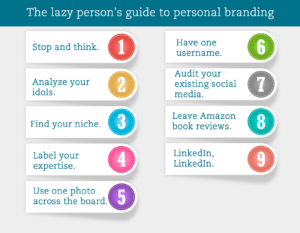
You have a personal brand, whether you like it or not.
Thanks to the Internet, everyone can present a shiny, online version of themselves as a quick way to cash in. Personal brands are no longer just for stars like Oprah or Beyoncé. It’s an important way to set yourself apart from the loud voices crowding online culture.
But where to start? It has become its own business, with various experts in the field telling you what you can and can’t do. It can be an intimidating experience for someone who has social media platforms like Twitter or LinkedIn, but might not know how to use them.
Here’s where the aforementioned experts come in. We spoke to LinkedIn’s career expert Nicole Williams, author and branding expert Dan Schawbel and social media expert Krista Neher to get the lowdown on the laziest ways to kickstart your personal brand.
1. Stop and think.
Before you get started launching your brand, sit back and think — “What is my brand?” If you’re stumping yourself, Schawbel recommends reaching out to others. Ask family, friends, coworkers, managers — anyone who has knowledge about what your area of expertise might be. Identify what it is you gravitate toward.
2. Analyze your idols.
Who do you admire in the personal branding kingdom? Are you more Gwyneth Paltrow than Martha Stewart? Do you align yourself with overall brand masters like Sean Combs? Williams recommends identifying people who inspire you, whether they’re celebrities or people you know.
Pick five people, and describe them each with three adjectives. Through that exercise, you’ll get an idea of what it is you value most and how those values apply to your brand.
3. Find your niche.
If you’re fighting to be a generalist, you’ll get lost in a sea of similar people.
“Let’s say it’s your wedding,” Schawbel tells Mashable. “Do you go for just a photographer, or do you go for a photographer who specializes in weddings?”
Companies are always looking to hire people who have a core area of expertise. Be as specific as possible, because you simply don’t have the resources to have mass appeal. If you’re a social media expert, you have to dig deeper — maybe your social media skillset would apply best to “small hospitals” or “Ivy League schools,” Schawbel suggests.
4. Label your expertise.
Once you have that niche market down, make sure it’s in all of your social media profiles. This is imperative for being searchable, Williams says, so those who are looking you up can easily identify your profession.
One key mistake young people make is using a catchy but esoteric title
One key mistake young people make is using a catchy but esoteric title, like “architect of ideas,” Williams says, instead of specifically saying “marketing major.” Title your area of expertise with something specific, but unique, and then make sure it’s listed on all of your social accounts.
5. Get your opinion out there.
People who research you will want to know just how much of an expert you are in your chosen profession. Get your opinion out to the world, whether it’s via Twitter, Facebook or LinkedIn.
For example, if you’re a film expert who is particularly passionate about film criticism, share an interesting movie review and explain why you’re sharing it. Something as simple as “I enjoyed this critic’s language,” or “I disagree with the critique about the script,” shows people your personal connection and knowledge.
Williams recommends doing something like this at least once a week, so you build up your reputation.
6. Use one photo across the board.
Your photo is the strongest visual representation of your brand. One of the quickest ways to tie your social media accounts together is to use the same photo across all networks.
If you’re really antsy about sticking to one picture, make sure you use different ones that all tie back to the same brand. Are you an expert pastry chef? Use photos that represent that aspect of your life.
7. Have one username.
This might seem painfully obvious, but this is the lazy person’s guide after all. Consistency is vital in personal branding, Neher says. When you look at powerful brands, you notice there is consistency across all social platforms.
8. Audit your existing social media.
Google yourself and see what comes up. Then, look at the content you have on existing social media accounts. How would you define the person who appears?
Start just by looking at your Instagram account. What are the values represented on that page? For example, Neher looked at her own account and realized many of her pictures were of alcohol.
“While I do love a martini, the content of my account would make me look like I had a drinking problem,” Neher tells Mashable. “I applied a principle of balance — I still take pictures of drinks, but I also have professional content and other social content to balance it out.”
9. Leave Amazon book reviews.
If your social media footprint is a little light, Neher recommends leaving Amazon reviews for books in your field. It’s one of the first things that shows up if people Google you, and will automatically show people just how passionate you are about your area of expertise.
10. LinkedIn, LinkedIn, LinkedIn
You just have to have it. Williams, Neher and Schawbel all recommend having one. There are plenty of ways to optimize your LinkedIn account, if you’re a newbie, from using keywords to having a great photo.
Williams also recommends using LinkedIn’s blogging tool to share personal knowledge about your area of expertise. She has also written about the best ways to grow your network, from sharing links to congratulating people when they get new jobs or celebrate work anniversaries
